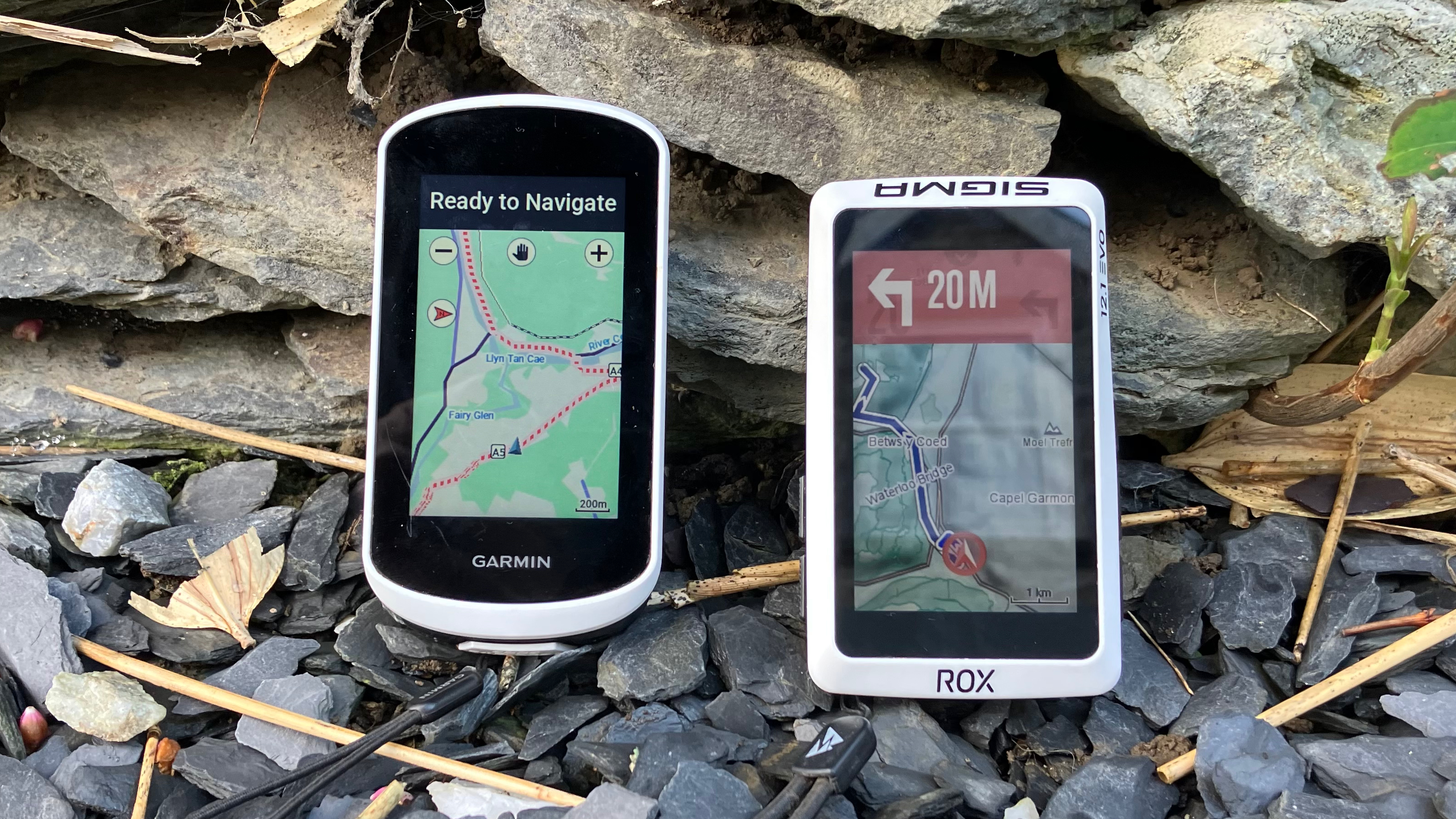
If you want a touchscreen bike computer with an emphasis on navigation, Garmin and Sigma should be on your shortlist, as they both make some of the best MTB GPS computers around. Most of Garmin’s touchscreen models are well over £400, with the diminutive Edge 840 starting at $449.99 / £449.00. But the recent, pared down Edge Explore 2 is only $299.99 / £249.00.
We’re going to compare it here with the same-sized Rox 12.1 Evo recently released by longtime German GPS brand Sigma. At $439.95 / £379.00, the Rox 12.1 is a chunk more expensive than the Explore 2, but it’s better specced, and still a lot less than the next Garmin up.
The basics
The two units are very similar in the basics. Both have a 3-inch, 240x400-pixel touchscreen. With a smaller bezel, the Rox is a centimetre shorter than the Garmin, but 4mm thicker, and they weigh almost the same, at 105g and 110g respectively.
The Garmin has three buttons – on/off, start/stop, and lap – everything else is done on the touchscreen. The Sigma has two extra buttons, which can be used for scrolling between screens or zooming, and its on/off button doubles as a home button, which can be handy.
Both devices can be submerged for up to an hour, though the Sigma is certified for dust protection too, and both use USB-C cables.
Battery life depends on whether you're using maps, and things like screen brightness and how many devices you've connected, but the Sigma is around 10-15 hours, and the Garmin is 15-20, with over 20 on low-power mode.
In short: The Sigma’s slightly more compact, but the main difference is its two extra buttons which duplicate some touchscreen functions.

Data screens
Both devices let you customise your data screens with up to 10 fields per screen (or as few as one), and multiple pages per sport profile.
One of the main differences is that Garmin allows three sports profiles, while Sigma allows 20. On the Sigma, I certainly found it useful to be able to have separate profiles for road, gravel and MTB, plus separate profiles for racing versus training and exploring.
The Sigma only allows three custom data screens per sport profile, while the Garmin lets you arrange your data over as many as 10.
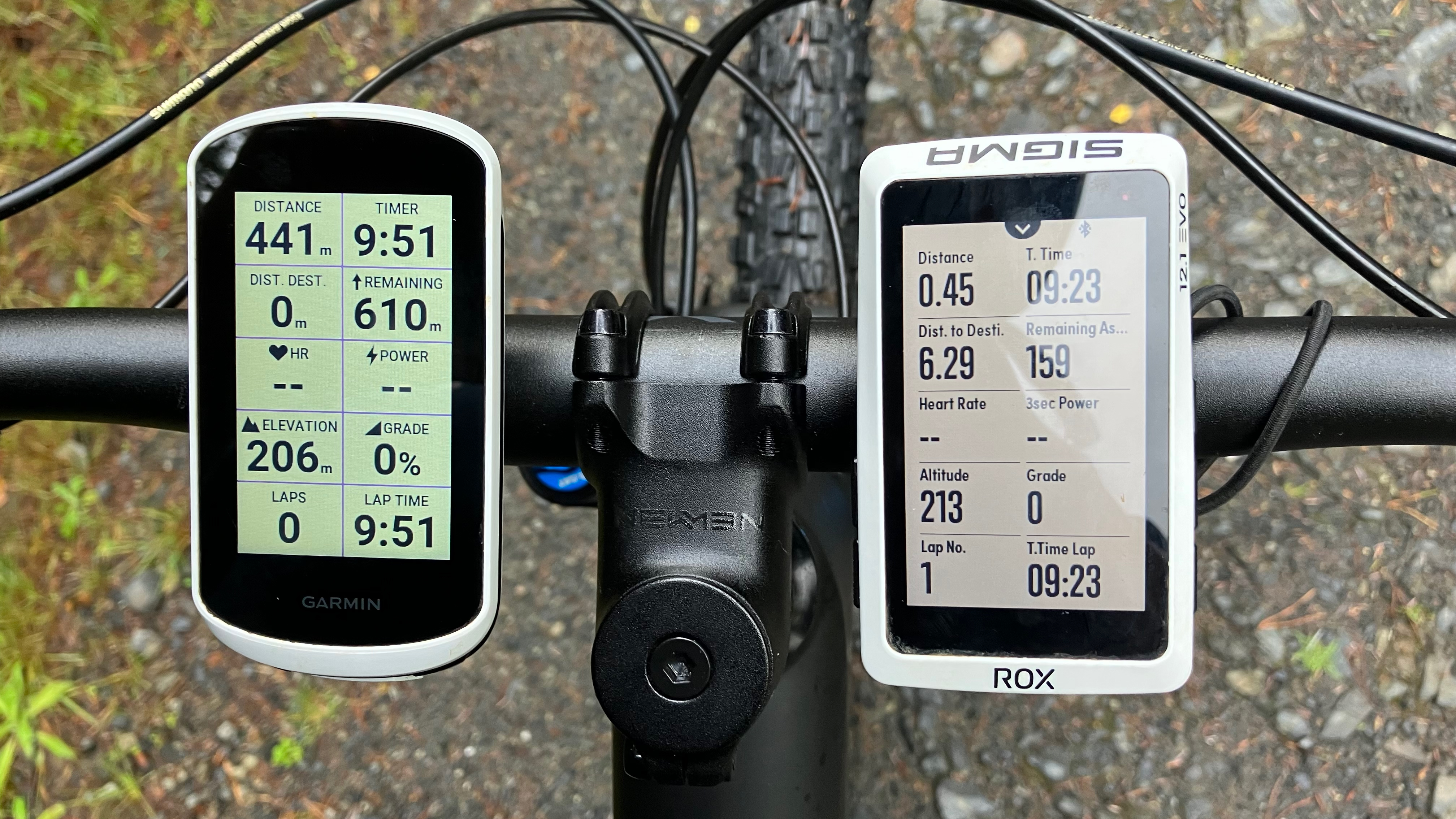
Some of the fields offer a deeper degree of sophistication on the Sigma – it can report on the power balance if you have a two-sided power meter for instance, and show your TSS as you train – but both have a mind-bending set of options. I appreciated some of the simplest the most, like time/distance remaining; the Garmin does a better job here as it includes elevation to the next waypoint or the end of the ride.
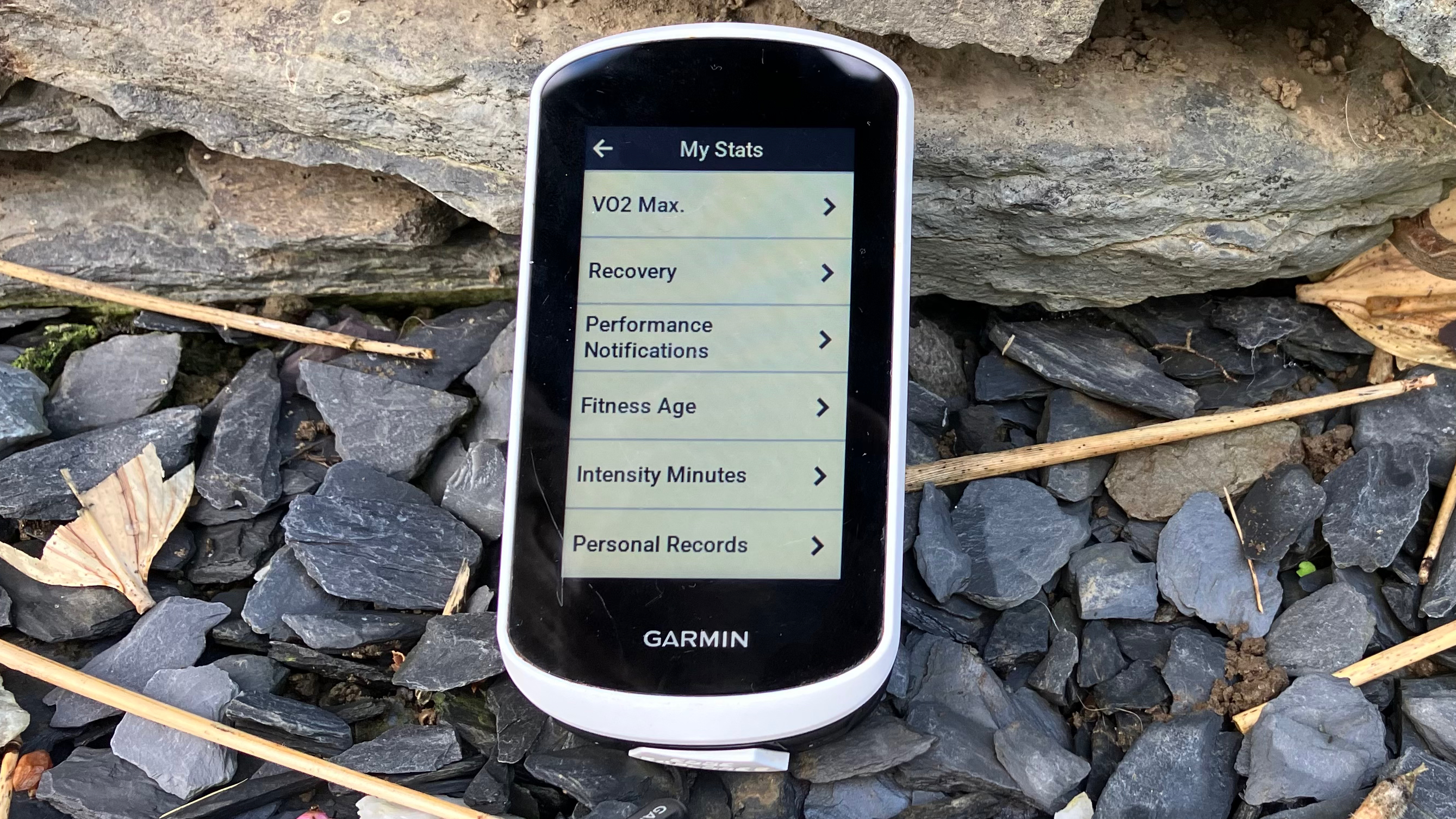
The Sigma is more oriented towards structured training, with target zones, and the ability to import structured workouts as .fit files from other apps. The Garmin has more of a fitness angle: it suggests recovery time after sessions and estimates your VO2 max, fitness age and more.
In short: Surprisingly close – both are impressive and very flexible. If you want separate sports profiles for racing, structured interval sessions, or more detailed power data, the Sigma is better. But small things like Garmin’s ‘elevation remaining’ function are super useful on the trail.
Compatibility and sensors
Both devices can connect to pretty much everything – the usual heart rate, cadence and power meters, electronic shifting, indoor smart trainers, your phone (for using the app and receiving notifications), and your e-bike. But the Sigma has more advanced compatibility, eg, your Shimano Di2 shifter buttons can control the GPS unit, and if your e-MTB has the right connectivity, the device can even make it eke out its power to last the length of the route you’re on. The Sigma also has direct wifi connection, so it can upload direct to Strava etc, whereas the Garmin doesn’t and has to connect via Bluetooth to your phone.
In short: The Sigma Rox gives you direct wifi connectivity and can sync with certain electronic components, while the Edge Explore 2 does not.
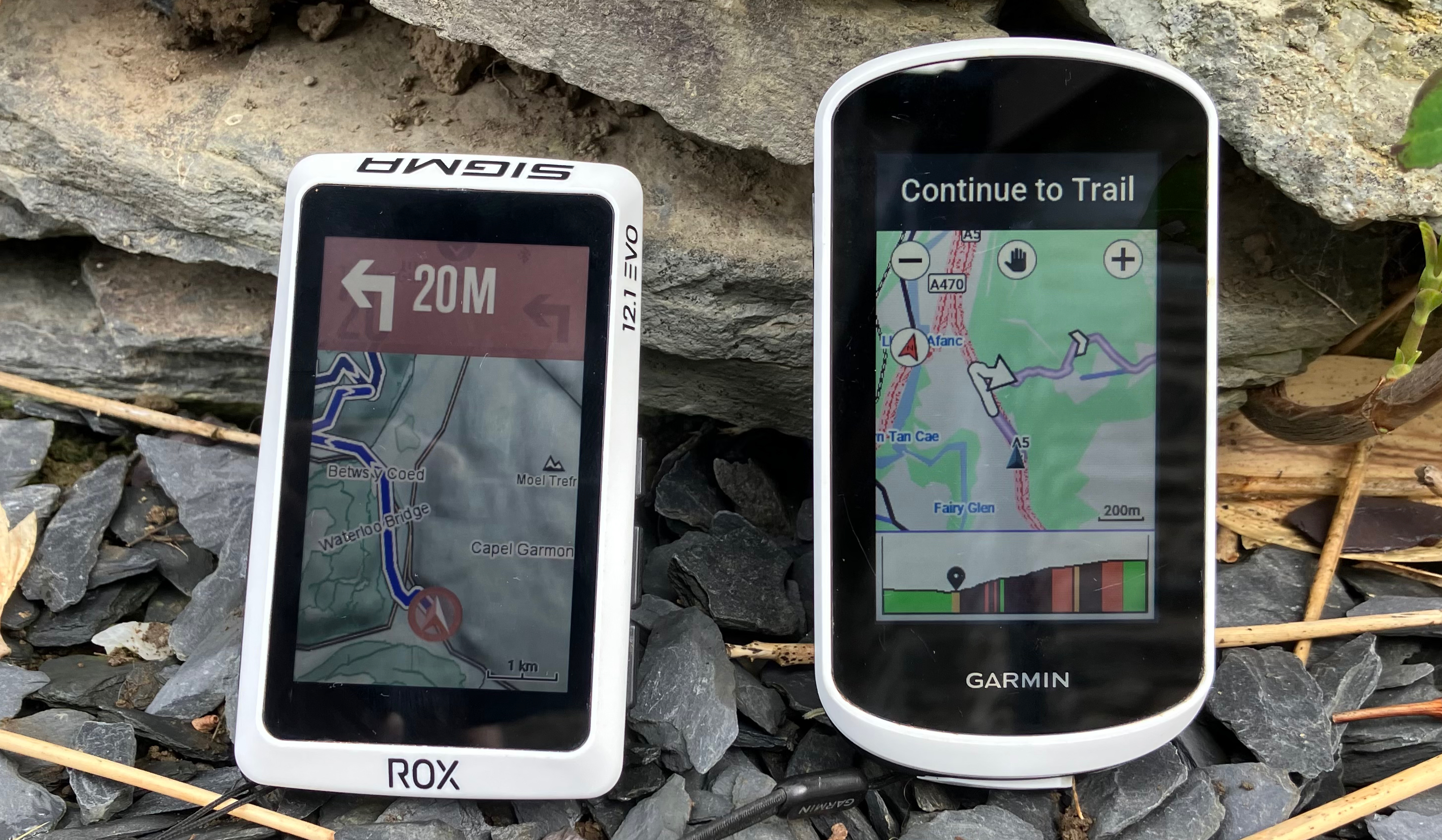
Navigation and maps
Both units have good default maps, but the main difference is that you can upload custom maps (like Trailforks, if you have a subscription) to the Garmin, and you can adjust the appearance of the maps on the Garmin, with options like high contrast mode, text zoom and zoom detail adjustment. These can make quite a difference, especially off-road.
Both devices have multi-band GPS and do a great job of latching on to satellite connection and keeping it. Both devices were impressive under tree cover, with each only occasionally going slightly awol. I thought the Garmin did a better job of detecting which way the unit was pointing, which can make a useful difference at junctions.
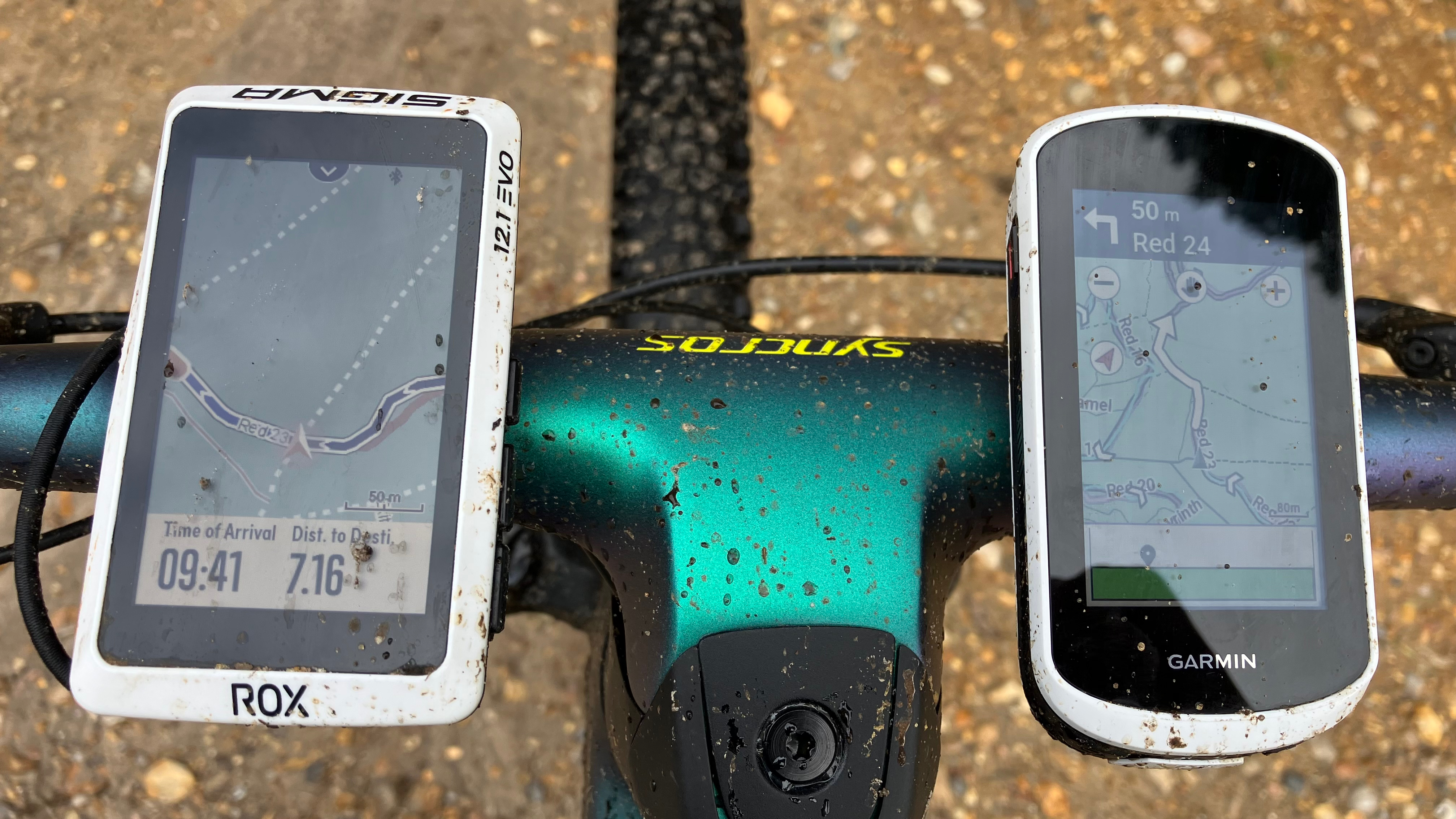
The pros and cons of each unit tended to balance each other out, especially as you can customise the screens so much. The Sigma was sometimes a touch more practical, like giving the option of navigating to the nearest point on a route, not just the start when you load it in.
However, I found Garmin’s maps and turn-by-turn functions were clearer. You can make the ‘distance to next turn’ show permanently on the Sigma, but that’s a default setting on the Garmin, and easier to read.

The Garmin’s ClimbPro was also way ahead of the Sigma’s route profile graph, especially in the way that the elevation profile automatically appears as you climb, and shows distance and elevation remaining. On the Sigma you’d have to set up a data screen to show the elevation chart, and then swipe to it as you rode. The Garmin even lists all the upcoming climbs and their gradients on a route preview screen.
In the setup pages on both devices, you can combine whatever data you want with the map view.
One personal niggle I had with the Garmin, though it might not bother you and you can switch it off, is that when you go off course, the re-route function doesn’t tell you to do a u-turn and can send you miles out of the way.
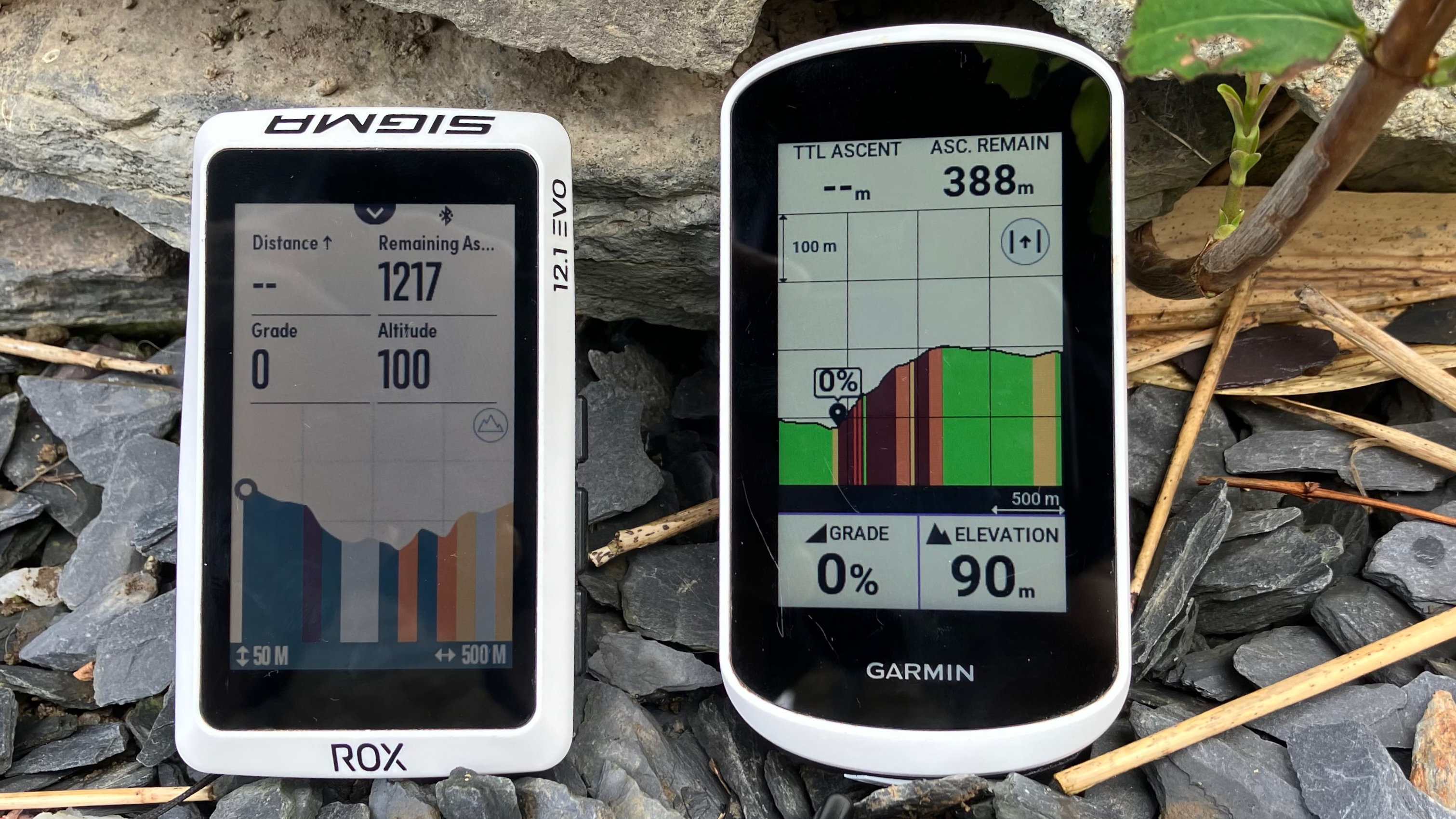
Both devices have a few additional fancy features with similar shortcomings. They both have directories of points of interest, like shops, cafes and water taps. They’re good if you know the name of the place you want, but just browsing them is nowhere near as good as using Google Maps because they tell you nothing about the places and some of the listings are years out of date.
For UK users neither unit would recognises a UK postcode, which is a pain and both units have ‘suggest a ride’ functions, which give a weird lucky dip of results. The Garmin is slightly better because it has a database of most-travelled roads and tracks, but either way, you’d be better off planning your routes on a laptop first.
In short: You’re unlikely to be disappointed with the maps or the turn-by-turn instructions on either unit. The Garmin wins for its additional flexibility and a particularly impressive climb visualizer.
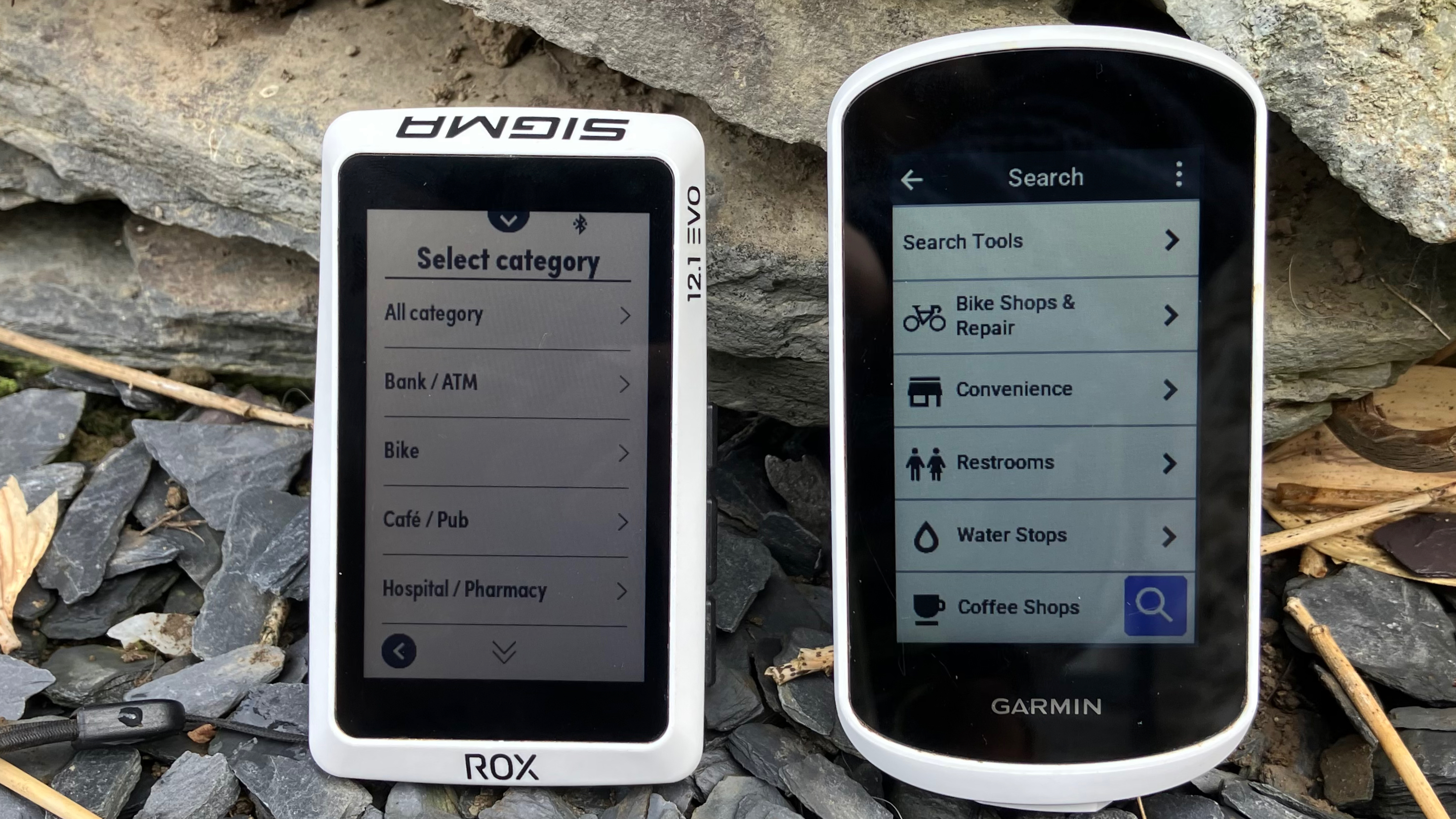
Off-road performance
If you have a Trailforks subscription, you can upload a Trailkforks map onto your Garmin and it’ll show colour grades for trail centre runs and more detail than you’ll get on the default Open Streetmap-based maps. The OSM-based maps do show things like trail names, which is handy for orientation, even if it’s not always clear where the start of a run is.
The Garmin does have an ‘MTB’ base map built in, but the only big difference compared with its general map is that it emphasises popular off-road trails more. In reality, we found the default clarity of the built-in Sigma map was just as good as the Garmin's off-road a lot of the time. Like Apple products, the Sigma gives you fewer customisation options but the defaults are pretty good. Garmin also has a built-in Trailforks app but it is just a list of rides with no descriptions, which pull into Garmin’s normal maps.

For UK riders, the maps on both units visually distinguish between bridlepaths (which you are allowed to ride) and footpaths (which you’re not) but sadly neither unit managed to recognise the difference when it came to creating automatic routes. The Garmin was better – maybe because of its ‘popular routes’ dataset – but you wouldn’t want to rely on either to keep you off unusable footpaths. The Sigma also ignored miles of bridleways sometimes, taking you on nearby roads instead. That’s a shame because they both have potentially great functions for returning you to the start, plotting a route to a point, or generating circuits.
In short: Both units are okay for off-road riding, though neither is super well adapted for it. They’re both good for following routes that you’ve uploaded and fine for manually seeing where you are at a trail centre. The Garmin has the potential for Trailforks integration but many Trailforks subscribers would prefer to use the more capable Trailforks app on their phone when out on the trails.
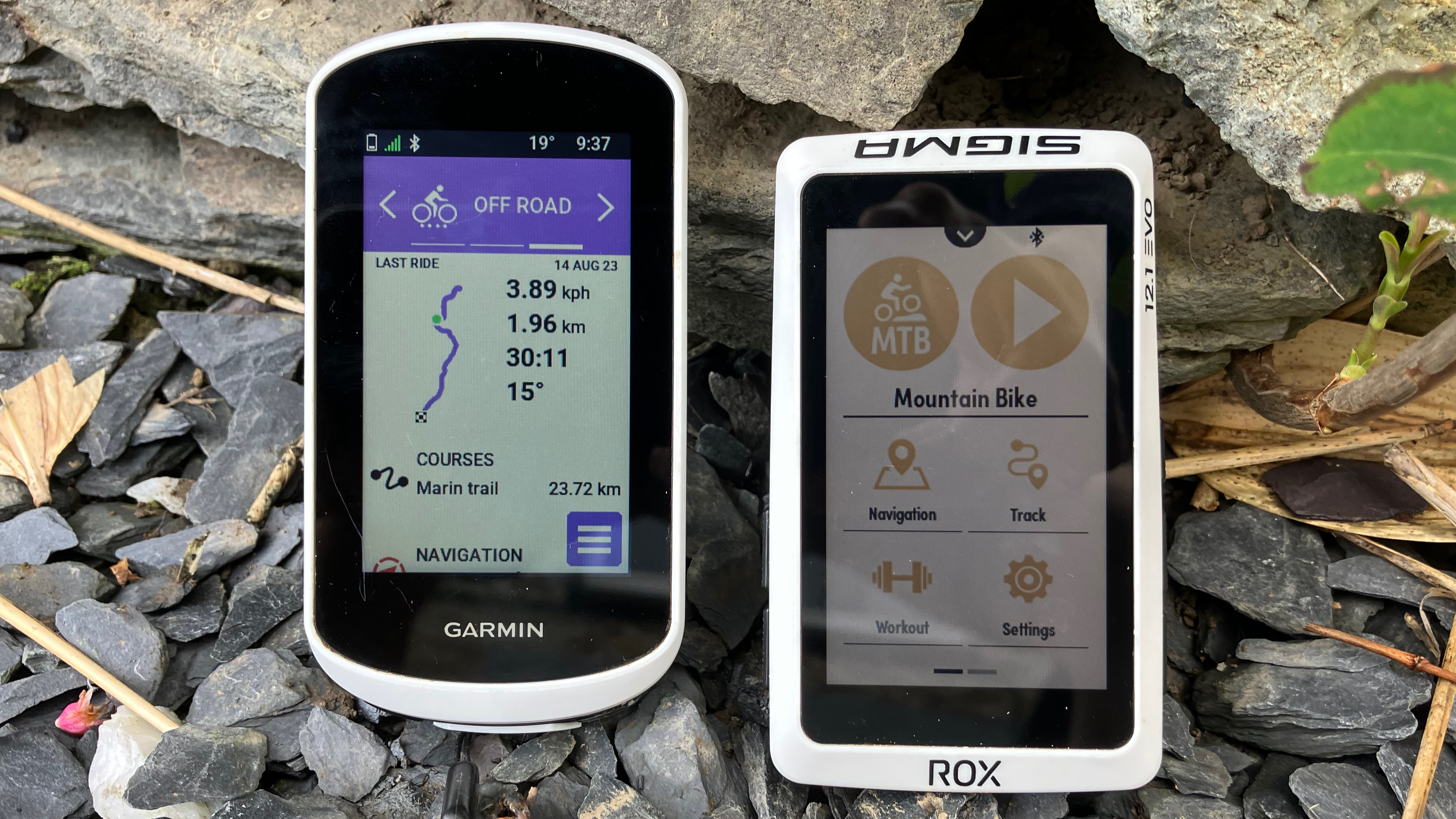
Ease of use
When you’re out on a ride, both units are clear and intuitive to use, even down to being able to press on a data unit (like power) on your display screen and swap it for something else (like heart rate) if you want. The Garmin is more complex, partly because of its interface, but partly because it has even more customisation options than the Sigma.
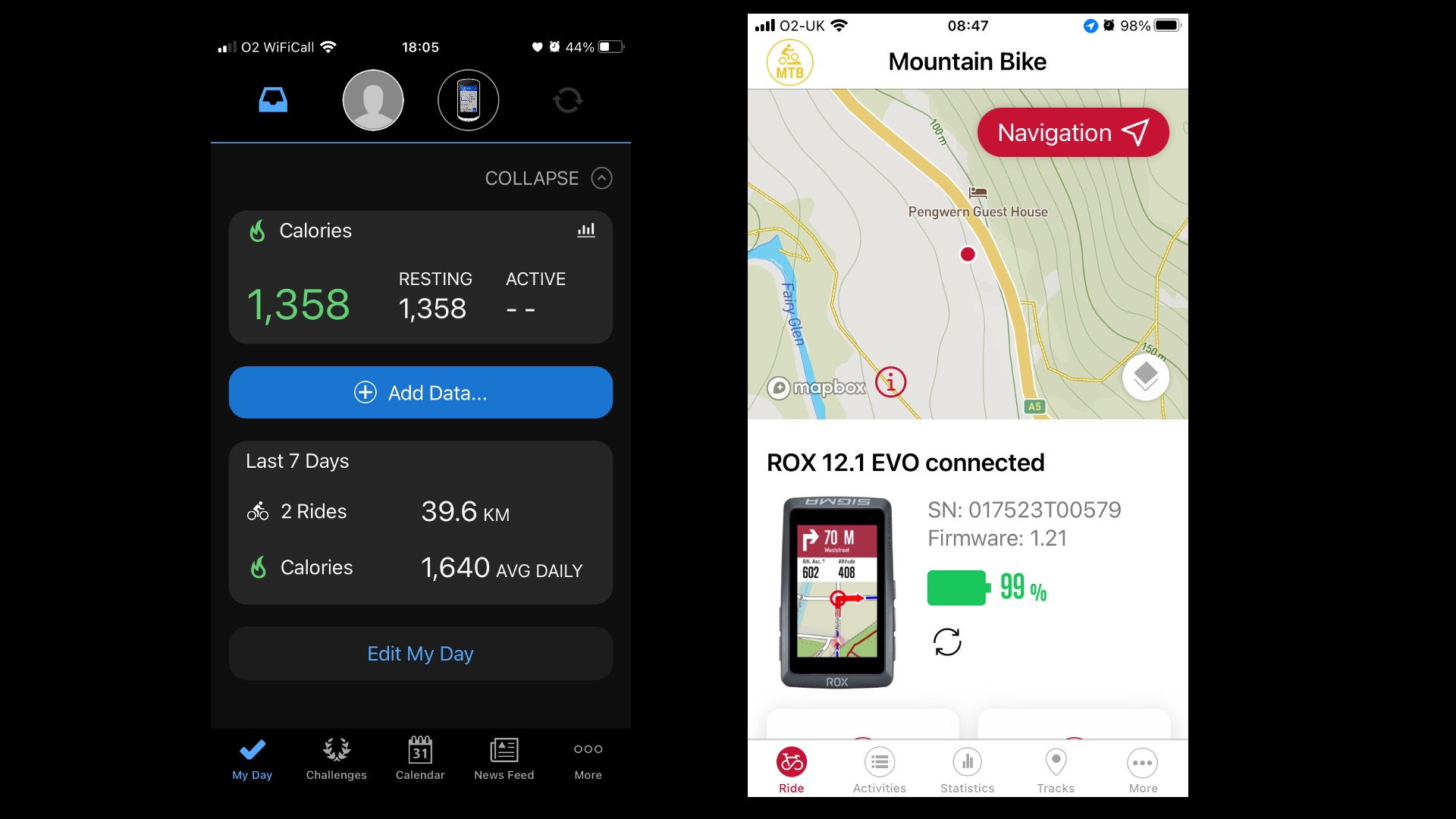
In terms of setup, preparing routes and using the companion app, the Sigma is streets ahead. The Sigma app has far fewer menu options, things are where you expect, and you can generally muddle through if you’ve forgotten how to do something.
There’s just too much going on on the Garmin app, and Garmin wants it to be the hub of your whole health and well-being lifestyle, rather than a way of getting things done on your GPS device.
In short: The Garmin can be frustrating but gets easy to live with as you get used to it and settle on the main features you want to use. But the Sigma is an easy winner here.
Should you buy the Garmin Edge Explore 2 or the Sigma Rox 12.1 Evo?
The Sigma Rox 12.1 Evo is a convincing step up from the Garmin Edge Explore 2 in most ways, including ease of use. Even though it costs 50 percent more, it’s still significantly less than the next Garmin up, and if you have the money, you’ll be unlikely to regret buying it over the Garmin.
The Garmin still offers good bang for the buck, especially for the quality of its touchscreen and its high-quality core navigation and training features; and some of its features like Climb Pro stand out above the Sigma.
For off-roaders, the Garmin is theoretically slightly better because Trailforks subscribers can upload the Trailforks map, and you can adjust the map settings more, but in reality, Trailforks works better on a phone, and I liked the default Sigma map well enough. Neither unit lives up to its route planning potential off-road, in the UK at least, and I hope that changes in the future.
For my use, I'd buy the Rox and set it up properly with racing and training and navigation profiles, and I’d be ready to experiment with its ability to run structured workouts. But if I was primarily using the unit for navigation, I’d choose the Garmin.
Tech specs: Sigma Rox 12.1 Evo
- Price: $439.95 / £379.99 / €379.99 ($539.95 / £469.99 / €469.99 with speed sensor, cadence sensor and heart rate strap)
- Colors: White/black, grey/black
- Weight: 110g
- Size: 106 x 54 x 17mm (depth excluding mount)
- Key features: Navigation with re-routing, multi-band GPS, 3in touch screen, companion app, customizable views, phone notifications, safety alerts, IPX7 water resistance, group ride features
Tech specs: Garmin Edge Explore 2
- Price: $299.99 / £249.99 / €299.99 – ($399.99 / £339.99 / €399.99 with on-bike power connectivity)
- Weight: 105g
- Size: 106 x 54 x 17mm (depth excluding mount)
- Key features: Navigation with re-routing, multi-band GPS, 3in touch screen, companion app, customizable views, phone notifications, safety alerts, IPX7 water resistance, group ride features







